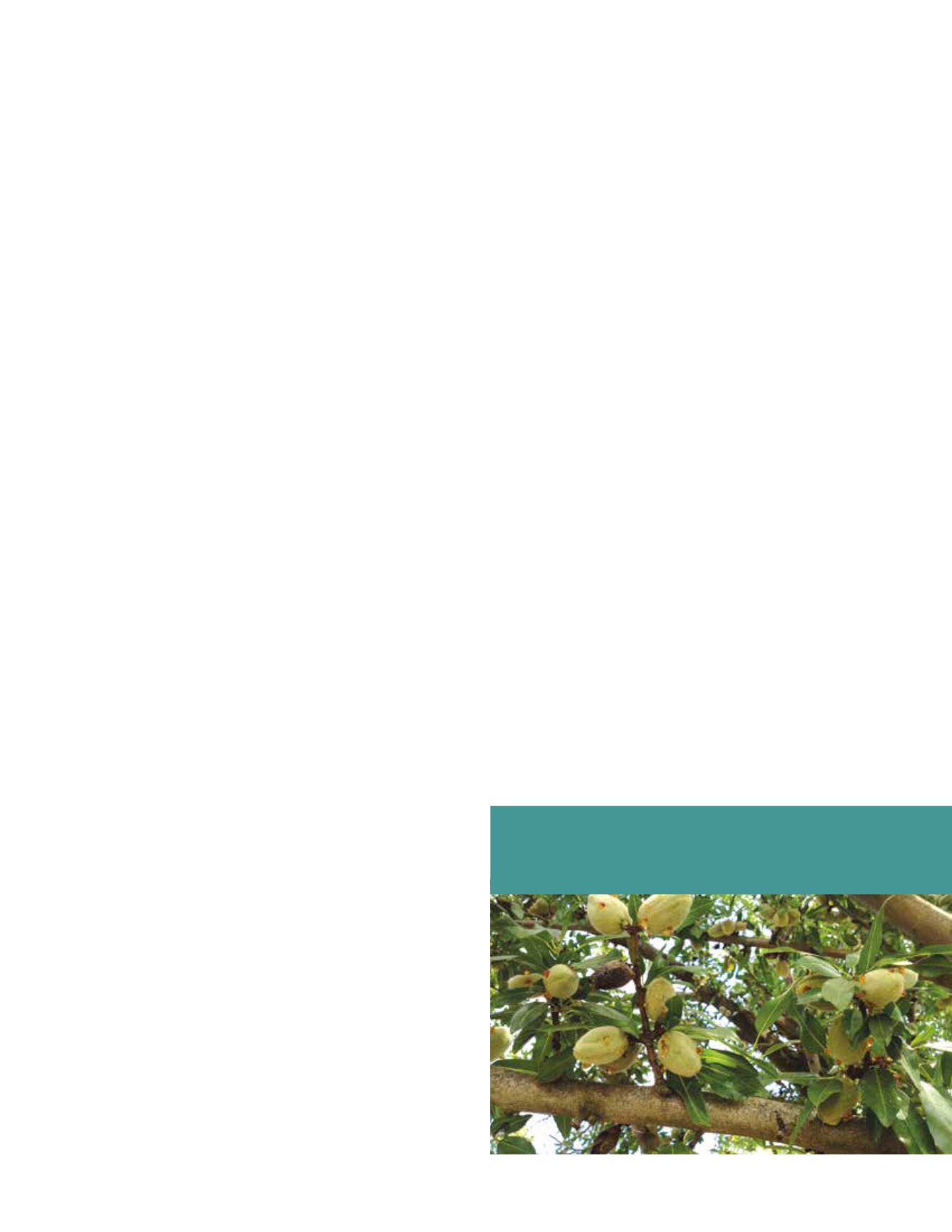
MARCH | APRIL 2017
Almond Facts
41
with lower water holding capacities, smaller, more frequent
applications should be applied. Young trees are more
sensitive to toxicity. Rates for each application should be
reduced to levels that are equal to one ounce of actual
nitrogen per tree for newly established trees, and two ounces
of actual nitrogen per tree for years two and three after
establishment. Multiple applications may occur through the
season to hit the targeted nitrogen budget.
Pest and Disease Considerations
for March/April
Disease concerns tend to run high in the spring as rains may
provide environmental conditions conducive for infection.
Sprays for shot-hole, anthracnose, jacket rot, and bacterial
spot should be based on rainfall events. Summer diseases of
rust and scab, however, may still be problematic and may
require a treatment even in dry spring conditions. Treatment
timings for scab is two to five weeks post petal fall, and
five weeks post petal fall or later for rust. Anthracnose and
bacterial spot proliferate in warm, rainy weather and may
require multiple treatments prior to rainfall events. Bacterial
spot treatments involve copper and mancozeb treatments
and should be considered in orchards that have a history of
disease. Please discuss the usage of copper with your PCA
or Farm Advisor as almonds are sensitive to this element.
Orchard history, cultivar, and irrigation systems should
be factors in determining the need for treatment. More
information can be found at the UCIPM website or in the
January/February
Time to Consider
column’s inserts
Insect concerns include San Jose Scale (SJS), Peach Twig
Borer (PTB), and Leaffooted Plant Bug (LPB). With the
warmer spring, male emergence for SJS and the biofix for
PTB may be earlier. Therefore, the traditional “May Spray”
timing may also be earlier. Timing of a growth regulator for
SJS control should be 400 DD after the male flight. A spring
treatment for PTB should be made 400-500 DD after the
biofix. Keep in mind that the PTB timing often overlaps with
the spring flight of NOW. If timed properly, this spray could
provide early season control for both pests.
LPB is erratic and hard to predict. Research does suggest
that over-wintering populations are reduced by below
freezing temperatures. In years with mild winters, such as
this past year, populations tend to be higher. Sprays should
be timed once adults are first detected, not once damage
occurs. Damaged nuts do not show symptoms for several
days to weeks after initial feeding.
Please keep in mind that there are more pests that affect
almonds during this time period. More information can be
found at ucipm.ucdavis.edu.
Weed Control
Most spring time weed control programs are reliant on
post-emergent herbicides, particularly glyphosate. These
products should be properly selected to provide control
of the “escaped” weeds from the winter pre-emergent
program. Over the past several years, however, we have
seen an increase in summer emerging weeds that are
either glyphosate-resistant or are variably controlled with
this herbicide (e.g. lambsquarter, threespike goosegrass,
and junglerice). If present, try alternative broadspectrum
“burn-down” products such as glufosinate or paraquat.
Alternatively, a “two shot” pre-emergent program could
also be considered to stretch residual weed control into the
summer. If a spring applied pre-emergent product is used, it
must be applied when there is enough rain or irrigation to aid
in its incorporation. This may mean that it is applied with
the last rains of the spring or in microsprinkler or solid-set
irrigation systems. The highest label rate may not be needed
to provide effective control at this time of year which may
help reduce costs. More information can be found on the
IPM page under weed management.
Be careful with post-emergent herbicide spray applications.
Winds tend to be variable in the spring which makes it
difficult to apply material in a timely fashion. Calibrate
equipment, check nozzle orientation and overlaps, and
replace nozzles as needed to help maintain proper spray
particle size to maximize coverage and minimize drift.
Utilize surfactants, water conditioners, and drift control
agents to increase efficacy. Be cautious when spraying around
young trees as some herbicides can cause damage. Generally,
I suggest that spring herbicide applications be made before
cartons are removed from two year old trees.
Bacterial spot can be a problematic spring-time disease in certain areas of
California. This disease was detected for the first time in California in 2013.
Warm, spring rains can create environmental conditions conducive for
disease. The variety “Fritz” is highly susceptible to this disease. Be on the
lookout for amber gum and lesions found on almonds.


